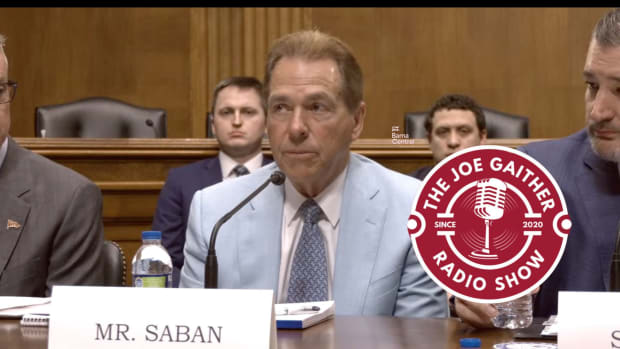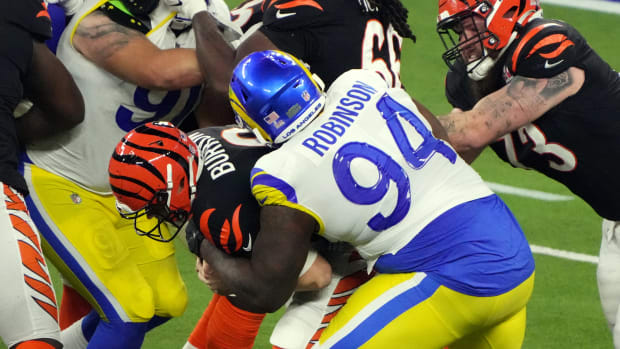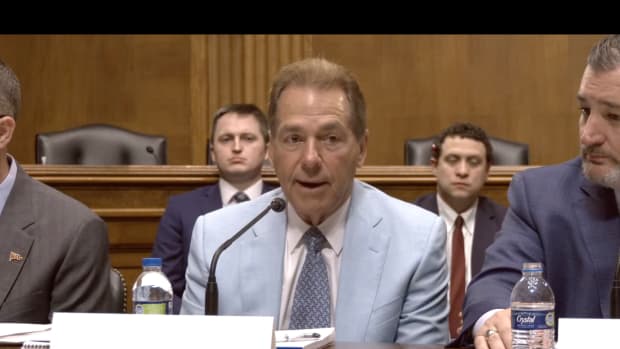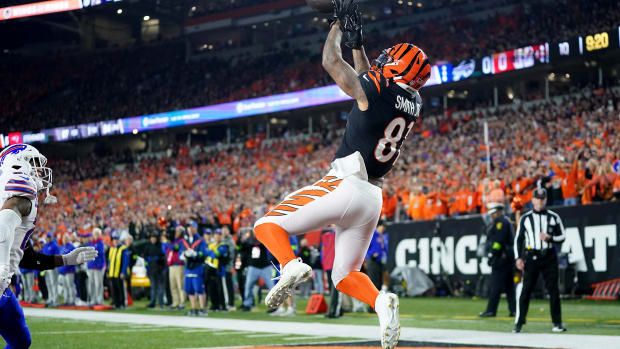Tale of the coaching tape: Nick Saban vs. Urban Meyer

Nick Saban is not perfect. He’s not even close.
Plenty of times he and the rest of the coaching staff have made the wrong decision regarding a recruit. Yes, he makes mistakes in games. There are a number of things he wishes he could have back, like when he didn’t call a prospective assistant coach back in 1990 after taking over at Toledo.
“He called my house and talked to Terry,” Saban said about his wife. “Terry really interviewed him. She told me when I came home that night. She said this really interesting guy called and really sounded like a top-notch, bright, articulate…
“You really need to talk to this guy.”
Saban didn’t. At the time he was with the Houston Oilers, trying to finish that season while hiring his first staff as a head coach and preparing for the move. It was one of the things that slipped through the cracks.
The guy who had called was Urban Meyer.
Oops.
Instead, when Earle Bruce got the head job at Colorado State, he hired Meyer as his wide receivers coach. Saban was left with a what-if story, while the thought of Saban and Meyer working on the same side might be enough to cause some coaches to second-guess their choice of profession.
“That was obviously one of the biggest mistakes I ever made,” Saban said.
Instead, Saban’s brief departure from the college ranks into the National Football League for the 2005-06 seasons coincided with the arrival of Meyer, who immediately replaced him as the toughest coach to beat in the Southeastern Conference.
Meyer had been a fast riser as a head coach, with Bowling Green going from 2-9 to 8-3 his first year, and after a combined 17-6 record over two seasons headed to Utah. With Alex Smith at quarterback, the Utes became not only the first team from a non-automatically qualifying BCS conference to play in a BCS Bowl, but won, dominating Pittsburgh 35-7 in the Fiesta Bowl.
But following Utah’s first perfect season since 1930, both Notre Dame and Florida came calling and to the surprise of some he chose the Gators and a lucrative seven-year contract that would pay $14 million, over one of the places he had been an assistant coach (1996-2000) and had repeatedly called his “dream job.” That Meyer also had to deal with former Florida coach Steve Spurrier being in the same division was problematic until he beat out Alabama for a player who would become the face of college football, Tim Tebow.
In 2006, the Gators survived the toughest schedule in the country to win the SEC championship and, thanks to UCLA upsetting Southern California in the regular season finale, played Ohio State for the national title. Although the Buckeyes scored on the opening kickoff, the Gators crushed them, 41-14.
“Honestly, we played a lot better teams than them,” defensive end Jarvis Moss said. “I could name four or five teams in the SEC that could probably compete with them and play the same type of game we did against them.”
Due to the defense being depleted by graduation and departures to the NFL the Gators stumbled in 2007, losing three games and failing to return to the conference championship, but they were once again considered the team to beat in 2008. A one-point loss led to “The speech” by Tebow, who promised fans “you'll never see a team play harder than we will the rest of this season.”
Florida went on to crush every subsequent opponent, with the closest score 42-14 at Vanderbilt, until it faced No. 1. Alabama and Saban in the SEC Championship. The game went back-and-fourth until Florida finally pulled away in the fourth quarter for a 31-20 victory, and went on to beat Oklahoma for the national title, 24-14.
“I'm not sure I enjoyed that last one enough,” Meyer said. “I'm going to enjoy this one.”
The 2009 team looked like it could even be better, and after running the table in the regular season the rematch in the SEC Championship Game was billed not only as being the exclamation point to Tebow’s career, but he was on the doorstep of going down as the greatest player in college football history and Florida being a dynasty. However, Alabama’s focus over the offseason was on beating the Gators, and it showed.
The Crimson Tide arrived at the Georgia Dome with a mile-wide chip on its collective shoulder and took it out on the Gators in a game that wasn’t as close as the 32-13 score indicated. Overall, Alabama pummeled Florida nearly across the board statistically, including first downs (26-13), rushing yards (251-88), time of possession (39:27-20:23), and third-down conversions (11 of 15 vs. 4 of 11). The Tide never trailed, scored on six of its first seven possessions (minus running out the clock before halftime), and pulled up in the fourth quarter.
Tebow’s last-gasp pass wound up being intercepted in the end zone by cornerback Javier Arenas, reducing the quarterback to tears on the sideline. Alabama fans refer to it as “Tebow wept.”
''He's a great player,'' said receiver Julio Jones, ''but man, we're tired of him.''
Mark Ingram rushed for 113 yards and three touchdowns and Greg McElroy, who landed at Alabama after it got beat out for Tebow, threw for 239 yards and a touchdown to claim the MVP award.
Although a great rivalry appeared to be brewing between the coaches, their regular-season rematch in 2010 turned out to be a dud as Alabama easily won at home, 31-6. It was the first of three-straight losses for Florida, and after a lackluster 8-4 season Meyer shocked the college football world by announcing that he was stepping away from coaching due to health concerns and to spend more time with his family.
In six seasons, the Gators had won 65 games, two Southeastern Conference championships and two national titles, but also had 31 players arrested from 2005-2010 – a stigma that would stick with the coach for years.
Meyer ended up working for ESPN for a year and then got back into coaching at Ohio State in 2012. He stepped down at the end of the 2018 season after being suspended for three games over his handling of domestic abuse allegations against an assistant coach.
Previously Meyer had called himself an “organizational freak,” who had a speed-based spread offense that was particularly difficult to counter, but the secret of his success wasn’t too difficult to figure out.
“Back as a player, I was always the hardest working guy,” he said. “I would be so upset with myself if I wasn’t. Was I the best? I was average, but I outworked everybody. As a coach, am I the smartest? No. But I believe that in a lot of areas I outwork a lot of guys.”
Nick Saban vs. Urban Meyer
(For consistency reasons, statistics through 2018 season)
Category, Saban; Meyer
Seasons 23; 17
Consensus national titles 6; 3
Top five finishes 9; 9
Top 25 finishes 16; 14
Overall record 232–62–1*; 187-32
Percentage 78.5; 84.5
Losing seasons 0; 0
Bowl record/CFP record 14-10; 12-3
Percentage 58.3; 80.0
Conference titles 9; 7
Conference record 138-42-1; 114-22
Consensus All-Americans 41; 15
First-round draft picks 34; 23
Record against ranked teams 82-40; 43-15
Percentage 67.20; 74.14
Record against Top 10 teams 42-21; 25-9
Percentage 66.77; 73.53
Ratios/percentages
National title seasons One every 3.8 seasons; 5.7
Consensus All-Americans 1.78 every season; 0.88
First-round draft picks 1.48 every season; 1.35
Average wins vs. ranked teams 3.57 each season; 2.53
Wins over top-10 teams per year 1.82 every season; 1.47
Some of the information in this report was also used in the book "Nick Saban vs. College Football."






